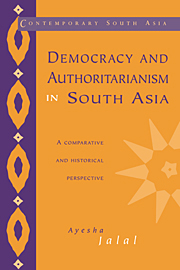Book contents
- Frontmatter
- Contents
- List of maps
- Preface
- Introduction
- 1 The colonial legacy in India and Pakistan
- 2 State formation and political processes in India and Pakistan, 1947 to c.1971
- 3 The ‘populist’ era and its aftermath in India, Pakistan and Bangladesh, 1971 to c.1993
- 4 The state and political economy, 1947 to c.1993
- 5 Central power and regional dissidence
- 6 Societies, cultures and ideologies: hybrids in contrived monoliths
- 7 Conclusion
- Bibliographical essay
- Index
5 - Central power and regional dissidence
Published online by Cambridge University Press: 26 October 2009
- Frontmatter
- Contents
- List of maps
- Preface
- Introduction
- 1 The colonial legacy in India and Pakistan
- 2 State formation and political processes in India and Pakistan, 1947 to c.1971
- 3 The ‘populist’ era and its aftermath in India, Pakistan and Bangladesh, 1971 to c.1993
- 4 The state and political economy, 1947 to c.1993
- 5 Central power and regional dissidence
- 6 Societies, cultures and ideologies: hybrids in contrived monoliths
- 7 Conclusion
- Bibliographical essay
- Index
Summary
For all their historical specificities subcontinental South Asian states and societies have kept a march ahead of the rest of the world in at least one important respect. The recent surge in assertions on ‘ethnic’ identity and demands for national sovereignty in the erstwhile Soviet Union, Eastern Europe, the Middle East, the United Kingdom, Canada and elsewhere is an old and familiar occurrence in the subcontinent. Indeed, the dialectic between centralism and regionalism has played a pivotal part in the more dramatic developments in subcontinental history. Frequently overlaid by communal, sub-regional, caste and class factors, the fluctuating balance between centre and region nevertheless has been something of a constant. Unflinching faith in the virtues of a strong central state authority proceeds from a clear recognition of the subcontinent's perplexing diversities, most with recorded histories of periodic defiance of attempts to bring the farflung frontiers of geographical India under a single political banner.
As if the weight of pre-colonial history was not burden enough, the partition of India in 1947 followed by the disintegration of Pakistan in 1971 have served as sharp reminders of the potency of centrifugal tendencies in the subcontinent. Far from encouraging greater flexibility towards the fact of diversity, both developments have turned the hearts and minds of influential segments in political society, to say nothing about the guardians of the state, against loosening the screws of centralized structures.
- Type
- Chapter
- Information
- Democracy and Authoritarianism in South AsiaA Comparative and Historical Perspective, pp. 157 - 200Publisher: Cambridge University PressPrint publication year: 1995



